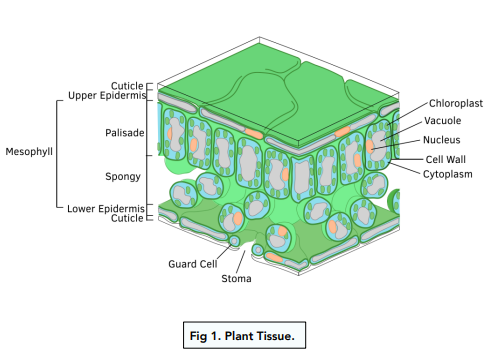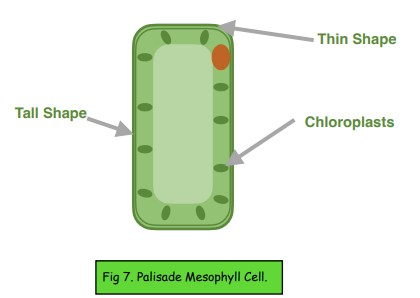Transport in Plants - How Plants are Adapted for Photosynthesis (GCSE Biology)
How Plants are Adapted for Photosynthesis
Adaptation of Leaves
Leaves are the main site of photosynthesis in plants so they are adapted for this in any ways:
- A transparent upper epidermis – this allows light to pass through.
- Waxy cuticle – decreases water loss from the leaf through evaporation.
- Broad leaves – increase the surface area of the leaf so there is more exposure to sunlight.
- Chloroplasts located near the top in the palisade mesophyll layer – this is so they can get the most light as this is where most of the plant’s photosynthesis takes place.
- Stomata (holes on the lower surface) – allow the movement of Carbon Dioxide and Oxygen into and out of the leaf as well as water vapour.
- Air spaces – increase surface area for gas exchange and allow gases to move more easily.
- Vascular bundles (xylem and phloem) – help transport water and sugars.

Palisade Mesophyll Cells
- Palisade cells are present in leaves and are adapted for photosynthesis. This is where most of the plant’s photosynthesis takes place. They have:
- Chloroplasts – these aid with photosynthesis in the cell.
- A tall shape – so they have a large surface area exposed to absorbing Carbon Dioxide.
- A thin shape – a lot of cells can be fitted at the top of the leaf which is nearer the light.

Photosynthesis is a process that occurs in plants, algae, and some bacteria, in which energy from sunlight is used to convert carbon dioxide and water into glucose and oxygen.
Photosynthesis is essential for plants, as it provides them with the energy they need to grow and develop. The glucose produced during photosynthesis is used as a source of energy and building material for the plant, and the oxygen is released into the air.
Plants have several adaptations that help them to carry out photosynthesis efficiently, including:
Chloroplasts: Specialized organelles in plant cells that contain chlorophyll and other pigments to absorb light for photosynthesis
Leaves: Large, flat structures that are covered in chlorophyll to maximize light absorption
Stomata: Small pores on the surface of leaves that allow for the exchange of gases, including the uptake of carbon dioxide and release of oxygen
Xylem and Phloem: Specialized transport systems in plants that help to distribute water, nutrients, and glucose produced during photosynthesis to all parts of the plant.
Transport in plants plays an important role in supporting photosynthesis, as it helps to distribute water, nutrients, and glucose produced during photosynthesis to all parts of the plant. The xylem and phloem are specialized transport systems in plants that help to move these substances around the plant, ensuring that each cell has the resources it needs to carry out photosynthesis.
The stomata are small pores on the surface of leaves that allow for the exchange of gases, including the uptake of carbon dioxide and release of oxygen. During photosynthesis, carbon dioxide enters the leaf through the stomata, and oxygen is released. The stomata also play a role in regulating the amount of water lost by the plant through transpiration, which is essential for maintaining a balance between water uptake and water loss.
Chlorophyll is a green pigment found in chloroplasts in plant cells, and is essential for photosynthesis. Chlorophyll absorbs light energy from the sun and uses it to convert carbon dioxide and water into glucose and oxygen. The green color of chlorophyll helps to absorb more light and maximize the efficiency of photosynthesis.
Transpiration is the process by which water is lost from a plant through the stomata on its leaves. This process helps to transport water and nutrients from the roots to the rest of the plant, and also helps to regulate the temperature of the plant and maintain a balance between water uptake and water loss. Transpiration also plays a role in supporting photosynthesis, as it helps to bring carbon dioxide into the leaf through the stomata, where it is used in photosynthesis.
The structure of the leaf is optimized for photosynthesis, with a large, flat surface area covered in chlorophyll to maximize light absorption, and stomata to allow for the exchange of gases. The veins in the leaf also help to transport water, nutrients, and glucose produced during photosynthesis to all parts of the plant.






Still got a question? Leave a comment
Leave a comment